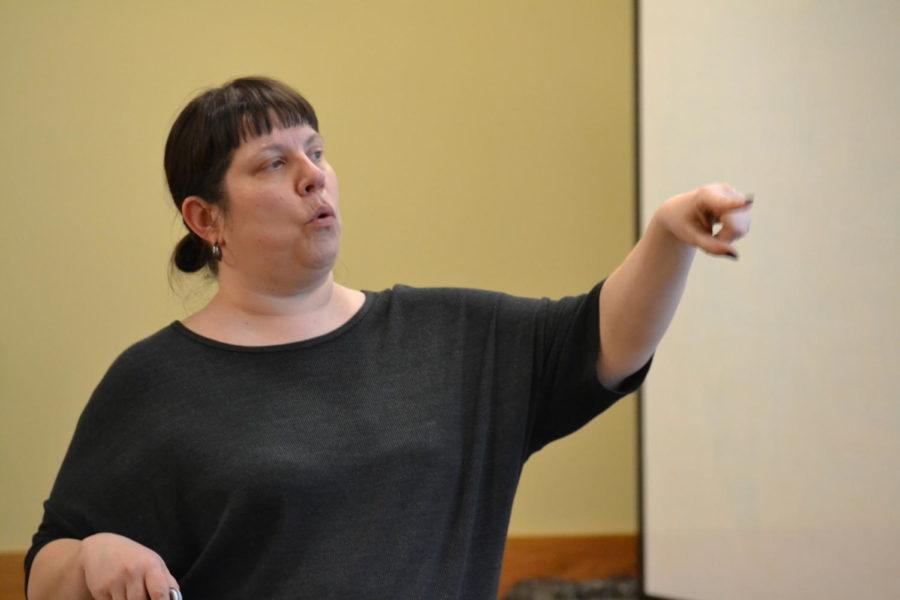Human Trafficking: It can happen to anyone
Dr. Allissa Stoehr, a sociology lecturer, presents The Realities of Human Trafficking in UDCC 136 March 6. Stoehr presented information on laws and resources in Iowa about issues pertaining to human trafficking.
January 20, 2018
Human Trafficking is something that is all too common in Iowa. From victims of trafficking found in a strip club in Denison, Iowa, to a young girl trafficked from Hy-Vee in Cedar Rapids, Iowa, it happens and Alissa Stoehr, lecturer in women’s and gender studies and sociology, made sure students at Iowa State are being informed about this topic at the Honors Seminar titled Human Trafficking in the United States Friday.
Along with other seminars such as this, Stoehr also teaches a women’s and gender studies course titled Human Trafficking where she discusses human trafficking on a more in depth level.
Human Trafficking is defined as the illegal movement of people, typically for the purposes of forced labor or commercial sex exploitation.
An important difference to note is between trafficking and smuggling.
Smuggling is the bringing or attempting to bring a person into a country in violation of immigration or other laws. It is also important to note that smuggling involves consent of the person being smuggled.
Trafficking is induced by force, fraud or coercion, and these crimes are committed against the individual with no consent.
There are an estimated 21 million victims of human trafficking globally at any one time.
One hundred thousand people are trafficked each year in the United States.
The Trafficking Industry is a $150 billion industry worldwide.
There are approximately 10,000 child sex trafficking reports annually.
Stoehr pointed out there are huge discrepancies in the numbers on trafficking depending on the sources you look at. This is because human trafficking is a hidden crime.
“You will find a wide variety of numbers, so when you are trying to prove your point about trafficking, people are always afraid about numbers because they want their numbers to be significant,”Stoehr said.
Victims are afraid to come forward because of fear of violence or other obstacles.
Threats such as “it was your fault,” “no one’s going to believe you” and “I’ll kill your family if you say something” are common.
Discrepancies in the definition of victims of human trafficking between the U.S. government and anti-human trafficking organizations also play a part.
The United States government defines trafficking as “holding someone in a workplace through force, fraud or coercion.” This definition also includes psychological abuse and sex trafficking.
“Our government did a really good job on dictating what human trafficking was,” Stoehr said.
The Department of Health and Human Services certifies trafficking victims in the United States after verifying they were subjected to forced sex or labor
“If they don’t see A, B, C and D, then they’re not a trafficking victim,” Stoehr said, “that can be problematic.”
Three to 6 p.m. and 4 to 8 a.m. are the most common times that trafficking occurs.
On average, a trafficking victim goes back to his or her trafficker seven times.
The average number of customers that sex trafficking victims see per day is 15.
Thirty percent of buyers of human trafficking victims are married couples.
Fifty percent of pimps and traffickers are females.
The internet and social media also play a role in human trafficking. In 2014, there were at least 12,000 ads per day on social media pertaining to human trafficking.
On netflix, there is a film titled “I am Jane Doe” which talks about human trafficking and human trafficking through Backpage.com.
Stoehr also mentioned movies, such as “Taken,” that give an incorrect view into what human trafficking is.
“Most trafficking is not like that, that’s the media glamorizing it,” Stoehr said.
In Iowa, the state patrol and other law enforcement agencies are still at a 1964 staffing level. This means these agencies have the same amount of staff they did in 1964.
“It is easier to traffic in a small town than it is in a bigger town” Stoehr said, “they may not get caught in a small town like Hills, Iowa.”
There have been 239 cases of human trafficking reported in Iowa since 2007 and 42 cases reported in 2017.
Human trafficking is an extremely important topic because it can happen to anyone.
“Just because you’ve taken a class on human trafficking or came to the honors salon, or think you’re aware of your surroundings, things can happen,” Stoehr said. “You’re not immune if you’re educated.”
Stoehr is using her knowledge to help students understand the realities of human trafficking and is bringing light to a topic that is very prominent in our society.
“Because of my passion of teaching, I just want [students] to be aware of their surroundings. I don’t mean to scare students or overwhelm them, but my goal as an educator is to educate my students about what could happen to them, to their family, to their friends,” Stoehr said.
Resources to learn more about human trafficking:
The Polaris Project at www.polarisproject.org
The National Human Trafficking Resource Center at www.humantraffickinghotline.org
ISU Network Against Human Trafficking and Slavery
Iowa Network Against Human Trafficking and Slavery at www.iowanaht.org
If you see something, say something
The National Human Trafficking Resource Center hotline at 1-888-373-7888
Online at https://traffickingresourcecenter.org/report-trafficking







